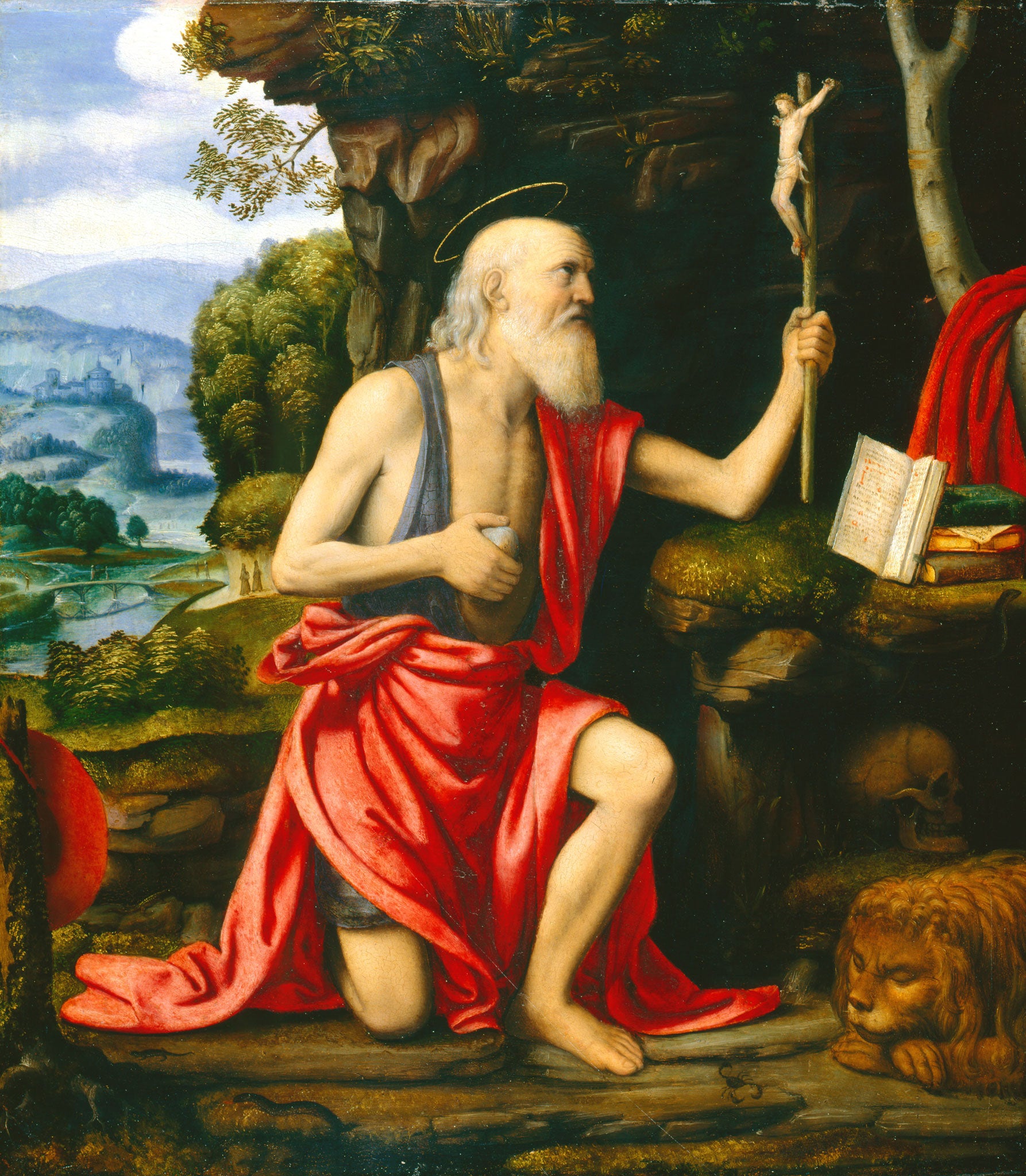Great works: Penitent Saint Jerome in a Landscape, c.1520s, by Bernardino Luini
Private collection

What first springs to mind when we look at this painting by the 16th-century Lombard master Bernardino Luini is a line of poetry by that gay Latinist of the late 19th/early 20th century, AE Housman: "What are those blue remembered hills?" Although probably just as familiar these days as the title of a play by the late, great Dennis Potter, these words in fact first appeared in A Shropshire Lad, which was published in 1896. The poem then continues with a reference to a land of lost content.
Lost content here? Hardly. This grotto, overlooking the hills of northern Italy, seems to contain an old hermit utterly at ease in his own devotional set-apartness. Surely this is a rocky, bosky, elevated perch of extreme ascetic contentment. It looks a relatively straightforward painting, and a beautifully organised one too (Luini had several goes at this theme), but in fact it holds various ways of remembering St Jerome, whose portrait this is, in a fine balance. Jerome, who was one of the four Fathers of the Latin Church, was generally depicted in three rather different ways. This painting, quite deftly, manages to combine them all.
Most familiar perhaps is the side view of Jerome sitting at a desk in his study, the light of divine illumination streaming through the window, busy at his soon-to-be-celebrated translation of the Vulgate – which means the Bible translated into Latin. One of the most wonderful renderings of this version of Jerome lives high on a right-hand wall in the principal chamber of the Scuola di San Giorgio degli Schiavoni in Venice, and it is by the wonderful Venetian narrative painter, Vittore Carpaccio. There Jerome is principally a scholar – and that scholar is alluded to here in the pile of books we can see here, sitting untidily on a ledge in front of him, one propped open.
The lion we can observe on this page is in Carpaccio's painting too. Our lion looks a little like a lovable, harmless door stop, more stuffed than real, and made redundant perhaps because mountain grottoes of this kind tend to lack entrances requiring a fanged guard. Had Luini ever seen a lion? The way those paws are crossed one upon another seems surprisingly human, as is that extravagantly fanciful backwash of curls, beginning so neatly at the line of the forehead, and which looks as if it might continue as far as the ropy tail and even beyond.
The second Jerome was a hermit and a dedicated ascetic who happily flagellated himself. That Jerome is here too in the rock he seems to dandle in his right hand as he gazes at the crucifix. Has he been beating himself recently? Are there wounds on his chest? Perhaps there is some horizontal scarring, but it is not given much emphasis. Is there blood? No. What we see is an old man, kneeling with an almost courtly degree of respect and decorum, who looks surprisingly lithe and limber and youthful in many respects – more, in fact, than his beard might suggest.
This is not so much Jerome the flagellant as Jerome the contemplative penitent, drawing spiritual succour from that image of Christ crucified, held firmly in the grip of his left hand, and which is made all the more dramatic, keyed to a higher pitch, by being set against the darkness of the grotto's entrance.
And then there is a third Jerome, slightly at one remove from the ascetic flagellant. This is Jerome as a cardinal of the church, raised high in the ecclesiastical hierarchy. He too is present, but this Jerome is also a little understated.
Nevertheless, he represented here by his red Cardinal's cap, partly in shadow, which hangs from the stump of the tree at the bottom left hand corner of the painting. We admire the way that it hangs – it helps the hat to keep its shape and physical definition, and therefore be all the more recognisable for what it is. And perhaps there is more than a hint of the worldly sumptuousness of the trappings of a cardinal of the church in the quality of the sumptuous fabrics which loosely and elegantly enwrap him.
After all, this is not some mere desert-meandering, locust-scoffing, honey-slurping John the Baptist, shrouding his nakedness with an animal's pelt.
About the artist: Bernardino Luini (1485-1532)
Born Bernardino de Scapis in Dumenza, a small town on Lake Maggiore, by 1501 the northern Italian painter known to the world as Bernardino Luini had moved to Milan with his father, and he subsequently completed his training in Venice. Little is known of his life, but many of his best works have a freshness and light-heartedness about them – in spite of the profound seriousness of many of his religious themes. He worked in the overbearing shadow of Leonardo, and this may have deadened his work somewhat.
Join our commenting forum
Join thought-provoking conversations, follow other Independent readers and see their replies
Comments
Bookmark popover
Removed from bookmarks